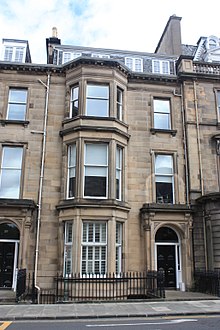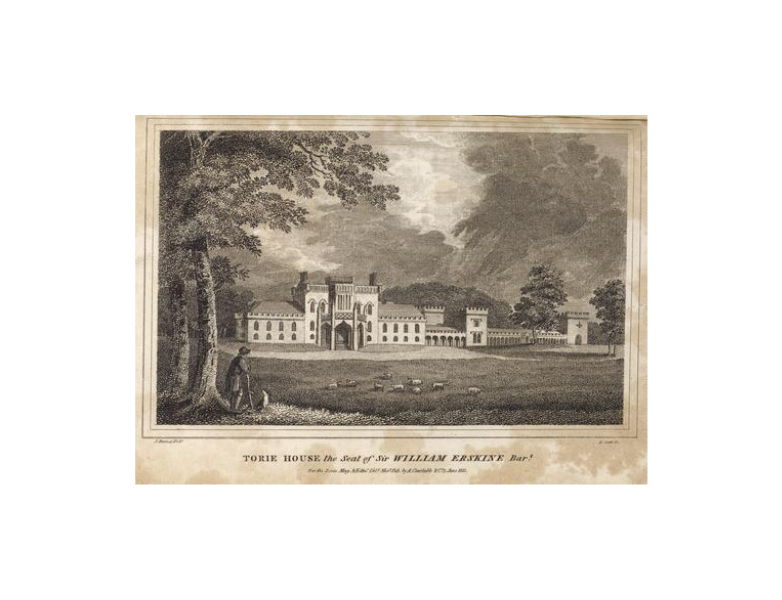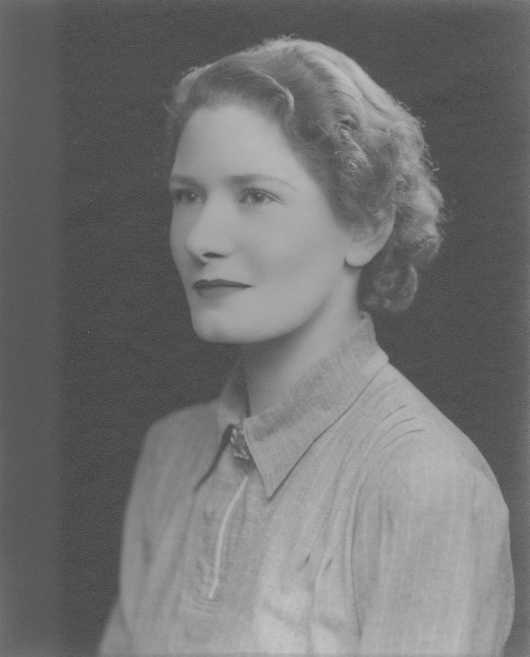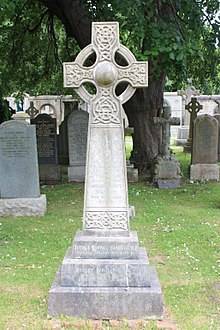
Worker of the Week is a weekly blogpost series which will highlight one of the workers at H.M. Gretna our volunteers have researched for The Miracle Workers Project. This is an exciting project that aims to centralise all of the 30,000 people who worked at Gretna during World War One. If you want to find out more, or if you’d like to get involved in the project, please email laura@devilsporridge.org.uk. This week, volunteer Marilyn shares her research on Thomas Goodall Nasmyth.
In an appreciation written by Dr C E Douglas and appearing in the British Medical Journal (BMJ) of 30th January 1937 alongside an obituary Thomas is described by his eminent colleague as “one of the strongest personalities, a man of the widest capabilities and sympathies in the profession of medicine. A splendidly built young man, taking to hunting and fishing. A keen and balanced mind. But if he had a great brain he had a bigger heart, and medical charities on a large scale appealed to him.” This high praise gives us a glimpse of the kind of person Thomas Goodall Nasmyth was.
Thomas was born on 28th February 1855 at Cardenbank, Auchderran, Fife to Isabella and James Armstrong Nasmyth. His father was a coal master, which was the “ owner or lessee of a mine”. Thomas was the 4th child of 7, 5 sons and 2 daughters. The 1861 census lists the family as living at Easter Bucklyvie,(also referred to as Bucklyvie Easter) Aberdour, Fife.
By 1871, aged 16, Thomas was living at The Farm of St Clement’s Well , Tranent Haddington, Midlothian sadly now a housing estate according to Google maps. He resided with eldest brother Alexander now 23 and a colliery manager , his older brother John, 17 years old, and Mary Andrew, aged 59 who was a servant. John and Thomas were pursuing life as a “student of art” although it is not clear where this studying took place.
In 1876 Thomas aged 21, graduated from University of Edinburgh with MB ChB ( Bachelor of medicine and surgery)
On 7th November 1882, Thomas, described on marriage registration as a bachelor of medicine, aged 27, married Violet Nicol Denny aged 23, a spinster at Woodlea Dumbarton. Violet was the daughter of Archibald Denny, shipbuilder, deceased, Thomas was pursuing a career in General Practice in Beath Fife.
Exactly 10 months to the day following their marriage, Violet had a daughter, Jenny born at Beath, Fife on 7th September 1883. A second daughter , Isobel arrived in 1885 also at Beath, Fife.
1886 took him to Cambridge to gain a DPH ( Diploma in Public Health ) He studied for this whilst having a wife and 2 very young daughters aged 3 and 1. It is unclear whether he left his family in Scotland or whether they travelled with him.
A further qualification in 1887 from the University of Edinburgh completed Thomas’ training and in the same year he was elected a Fellow of the Royal Society of Edinburgh.
Thomas left general practice in 1889 when he was appointed as the very first Medical Officer of Health for Fife, Kinross and Clackmannanshire .
The 1891 census still shows Thomas , now 36 as a General medical practitioner. He, Violet and their two daughters continue to live at Foulford House, Beath, Fifeshire where they employed two servants, Elizabeth and Fiona Drysdale , 20 and 16.
In 1897, Thomas’ mother died aged 76 at Middlebank House, Dunfermline declared on her death registration as of “ senile decay” and certified by her son in his professional capacity.
The following appeared in the St Andrew’s Citizen on 22nd May 1915, referring to a cause Thomas had been concerned about since 1898. He was very influential in the ultimate bonding of whisky for 3 years as described below.
FORMER COUNTY MEDICAL OFFICER AND NEW WHISKY. Writing last week, the London correspondent of the Glasgow Herald supplies the following interesting local item : —“ There is good deal of pressure being brought to bear Westminster to secure the cancellation of the Chancellor’s proposal for the compulsory bonding of spirits for three years, but I gather that opinion on both sides of the House is with Mr Lloyd George and against any substantial modification of the scheme. Most people seem to think that most harm results from the consumption of raw spirits, and one member who holds this view strongly recalled to-day in the Lobby the entertaining story told to the Feel Licensing Commission in 1898. T. G, Nasmyth, formerly medical officer for Fife, Kinross, and Clackmannan, and now of Torrie House, Dunfermline. The story, which was intended to illustrate the deleterious effects of drinking new’ whisky, was related in these words to the Commission friend of mine experimented with two monkeys of apparently the same age, the same size, and the same species. To one of the monkeys he gave old matured whisky, and it got intoxicated quite quietly. To the other gave new whisky, and it became violently intoxicated and very much excited. A week or two afterwards repeated the experiment The monkey which formerly been given the old whisky was now given the raw article, with the result that it became violently excited, and the monkey which previously had become excitedly intoxicated from row whisky was given matured whisky. The effect was to produce a quiet, gentlemanly state of intoxication. Dr Nasmyth, accepting the results of this experiment as conclusive, advocated the retention of whisky in bond for two or three years–the proposal now made by Mr Lloyd George 17 years after Dr Nasmyth urged it upon the Licensing Commission.”
In 1899, according to his Wikipedia page, Thomas was one of the first people to begin to make a link between bovine tuberculosis and the human form which eventually and much later led to the widespread pasteurisation of milk. He published two papers “Hints about the prevention of consumption” and “ Milk borne diseases”. He also published a report in 1900 on “ Methods of Sewage Purification “There is no apparent evidence to corroborate any of the above , however , they are clearly within his professional remit and interest.
Thomas’ brother John aged 41 in 1894 , according to his death registration – a minister of the Church, single having suffered from Cardiac weakness for 10 years and dying of Cardiac Syncope, certified by Thomas.
A younger brother James Russell, single, passed away tragically in 1901 aged only 35. According to his death registration he was found dead near a railway goods yard in Inverkeithing, cause of death- drowning and “ not certified”. One can only surmise that this was a tragic accident or suicide. Thomas and Violet were living at St Micahel’s, Cupar, Fife, he listed as the County Medical Officer. Also according to the 1901 census, they had two domestic servants.
Their two young daughters now 17 and 16 were listed as boarders at St Leonard’s, Bishopshall, St Andrew’s.
Also in 1901, when his father and brother Alexander were partners of the Donibristle Colliery Company and both holding managing certificates, there was a mining accident where moss created an inrush into the workings resulting in the death of 8 men.
Barely 2 years later on 7th January ,James , Thomas’ father died aged 82 , of heart failure according to his death registration and certified by W R Nasmyth MD. There is no clear familial link to be sourced but it is highly likely that there is one.
Thomas’ parents had resided at Middlebank House, Dunfermline for many years. The Dundee Evening Telegraph 27th June 1903 headline Dunfermline Man’s Estate reported that James left an estate worth £266,091.14.6d. He wanted the house to stay in the family and his eldest son or subsequent sons could buy it for £10,000.
In 1906, Thomas travelled with his younger daughter Isobel from Glasgow to New York, leaving on 11th August. They travelled saloon or 1st class , Isobel aged 21 has no occupation, profession or calling but Thomas is described as a Physician.* They arrived back in Liverpool on 15th September aboard “Tunisian” of the Allan Line.** Also listed are 2 other Physicians so it is unclear as to whether his journey was a professional one. It is at this time that he took up his role as counsellor/councillor to the British Medical Association (BMA), a role he fulfilled until 1910.
 This was a sad time for Thomas. His older sister Isabella died aged 58 on 7th July 1908 at 17 Ainslie Place , Edinburgh although her death registration states clearly that her usual address was 27 Palmerston Place , Edinburgh. Isabella died of a sarcoma. She must have resided with Thomas and Violet. His eldest brother Alexander Hogg died on 3rd June 1911 at Middlebank House ( he must have bought the family mansion and estate for the said £10,000 as described above). According to his death registration he Alexander died of heart disease which he had suffered from for several year. Certified by W R Nasmyth MD.
This was a sad time for Thomas. His older sister Isabella died aged 58 on 7th July 1908 at 17 Ainslie Place , Edinburgh although her death registration states clearly that her usual address was 27 Palmerston Place , Edinburgh. Isabella died of a sarcoma. She must have resided with Thomas and Violet. His eldest brother Alexander Hogg died on 3rd June 1911 at Middlebank House ( he must have bought the family mansion and estate for the said £10,000 as described above). According to his death registration he Alexander died of heart disease which he had suffered from for several year. Certified by W R Nasmyth MD.
At this time Thomas was living at 27 Palmerston Place, a handsome house in the West End of Edinburgh.
 Thomas is described as 56 years old, and living by private means. Also living with him was Violet, aged 53, his wife, Jenny, aged 27, his daughter and Isobel, 26 years old, daughter. The household also maintained Margaret McClaren, 31, cook, Grace McFarlane, 24 housemaid, Margaret Melville , 23 table maid and Christine Smith 28 housemaid. All 4 staff had been with the family for 9 years.
Thomas is described as 56 years old, and living by private means. Also living with him was Violet, aged 53, his wife, Jenny, aged 27, his daughter and Isobel, 26 years old, daughter. The household also maintained Margaret McClaren, 31, cook, Grace McFarlane, 24 housemaid, Margaret Melville , 23 table maid and Christine Smith 28 housemaid. All 4 staff had been with the family for 9 years.
For the years 1912-1913, 1913-1914, 1914-1915 , the electoral register only shows Dr Thomas G Nasmyth , Dr of medicine as being eligible to vote in this household.
By 1915 , the valuation rolls show that Thomas not only was the proprietor and occupier of 27 Palmerston Place but that he also owned 8 Palmerston Place Lane *, house, stable, motor carhouse, and occupied by a coachman John McIntosh. This makes a 5th member of the paid household staff. This at a time when WW1 had begun.
1915 also saw his elder daughter Jenny aged 31 marry Adam Nimmo McKillop, Political secretary and son of ex MP for Stirlingshire , deceased, aged 38 at St Cuthbert’s, Church of Scotland, Edinburgh – a very grand building at the West End of Princes Street. In a small announcement of the forthcoming wedding The Scotsman 12th June 1915 it was described as “will take place very quietly on 24th June”. Interestingly , a very quiet wedding in a very large and important church building with two clergy officiating as reported in the Scotsman. The address given for Dr and Mrs Nasmyth is 27 Palmerston Place and Torrie House, Fife.
Adam was also Second Lieutenant 2//7 Royals Scots . Lothian Regiment as described on his wife’s death certificate. The newly weds took up residence at 27 Palmerston Place. It is unclear where sister Isobel was at this time
1916 was an eventful year. Thomas became a grandfather, at the age of 61, to Violet Leslie in May.
This was also the year that he responded to the Scottish Medical Service Emergency Committee ( SMSEC) call for war work. His registration document shows him as a retired medical officer of health and his residence would be Town House*, New Mills, Fife. Presumably this is when he took up his role at H M Factory Gretna as Administrative Medical Officer a role given his background in Public Health. This role appears to have been tailor made for him.
 We know that Jenny and baby Violet were living with her parents at Torrie House in September 1916 because an advertisement appeared in the Scotsman on 6th September 1916 for a nurse to travel with an officer’s wife and 4 month old baby to undertake nursery duties and babies washing. Apply Mrs McKillop , Torrie House. Her husband must have been away on war duties. The forces war record shows that his regiment served in Gaza and the Middle East before going to France in 1918. There is a break in his service between April and November 1917 – possible compassionate leave considering the events below?
We know that Jenny and baby Violet were living with her parents at Torrie House in September 1916 because an advertisement appeared in the Scotsman on 6th September 1916 for a nurse to travel with an officer’s wife and 4 month old baby to undertake nursery duties and babies washing. Apply Mrs McKillop , Torrie House. Her husband must have been away on war duties. The forces war record shows that his regiment served in Gaza and the Middle East before going to France in 1918. There is a break in his service between April and November 1917 – possible compassionate leave considering the events below?
Thomas became a Grandfather for a second time on 2nd June 1917, this time to twin boys Norman Nasmyth McKillop and James McKillop. Tragically, Jenny died on 24th July aged only 34. Her death registration states that she lived at 27 Palmerston Place, Edinburgh, was 34 years old. Cause of death “ nephritis ( Bright’s disease) 70 days and ureamia 2 days “ both of these diseases are of the kidneys and can be caused by pregnancy complications. One can only imagine how devastated Thomas and violet were to lose their daughter so tragically and as a physician not be able to save her. This left her widower with 3 very young children.

Violet Leslie, Thomas’ Granddaughter
I have included a photo of a grown up Violet Leslie who went on to marry and have 5 children, living to the age of 98.
Following the war , Thomas is listed on the electoral register for Edinburgh for 1920-21 as again residing at 27 Palmerston Place along with Violet his wife and 35 year old daughter Isobel who both presumably were now eligible to vote.
His son-in-law remarried in September 1920, Amy Dorothy Threlfall of Garstang in a ceremony in Kendal, Cumberland. She was a widow having lost her husband in 1919 in an accident in Syria. He is buried in Damascus. They went on to have at least one child, Ian in 1921.
Following his stint at Gretna and at an age when many men aged 66 would be slowing down Thomas put his mind and energy into becoming a town councillor for the ward of Morningside in Edinburgh. His proposal as a candidate appears in the Edinburgh Evening News , 25th October 1921 along with a photo of him and The Scotsman , Friday 28th October 1921. He was duly elected , a role he held on to until 1929.
He bought a large property in Morningside , Canaan Lodge, 41-43 Canaan Lane. This property was described in the To Let section of The Scotsman , 23rd October 1832 as having “ 3 public rooms, 7 or 8 bedrooms, besides extensive servants can, a well stocked vinery and greenhouses, a coach house, stabling and offices suited to the requirements of a first class establishment accommodation. …situated in its own grounds, with a large and beautifully arranged and comprising flower, fruit And kitchen garden”
During his prominent years on the Edinburgh Town Council we know from The Scotsman of 1st November 1922 that he joined the Board of Commercial Bank of Scotland.
It is also noted in his obituary , BMJ Jan 30th 1937 that during his active years he was “ frequently called as a witness to give evidence before various public committees and commisions and made valuable suggestions before committees of the House of Commons on such subjects as the miners’ eight hour day, diseases of the mining industry , and certification of death.”
It cannot be corroborated that the claims on his Wiki page that he published during these years.
Living in such a grand mansion he held a garden fete under the auspices of the Edinburgh Women Citizens’ Association where Mrs Violet Nasmyth realised a sum of £470. The Scotsman, Tuesday 1st July 1924. The article reads that:
Feminist Town Councillor
“The Edinburgh Town Council does not have many feminist member…There is one member , however, who takes a warm and practical interest in women’s work and welfare, and organizations.. Dr Nasmyth, a staunch believer according to his own confession in the value of feminism…in social and political work.”
He had varied interests . Reported in The Scotsman , Thursday 5th February 1925 Thomas was a member of the Edinburgh Show committee, actively looking for a suitable site to commence use from 1927.
The Dundee Evening Telegraph of Friday 13th July 1928 list Dr Thomas Nasmyth as a subscriber for a call for a crematorium in Edinburgh at East Warriston. At the time of his death he was a director of the Crematorium.
This is the same year that the St Andrew’s Citizen reports that “ Sr T G Nasmyth , Canaan Lodge, Edinburgh, formerly medical officer of health for Fife, has been appointed Deputy Lieutenant for Edinburgh . He is Bailie on Edinburgh Town Council.”
It is reported in The Scotsman 27th September 1928 that Thomas was part of the official vist of the Sultan of Muscat to Edinburgh. This would be part of his Deputy Lieutenant role,
Thomas was clearly a very prominent citizen.
The Dundee Courier Thursday 6th June 1929 reported that he retired from the council. At aged 74 he perhaps deserved a rest. He is also described as being an extraordinary director of Perth Show.
Sadly, at the age of 82, Thomas died at his home, Canaan Lodge, on 16th January 1937.
He was cremated on 19th January 1937 at Warriston – the crematorium he had fought to have built. The cause of death is registered as double pneumonia 4 days and cystitis. The crematorium record sourced via deceased online states that he was a Director of Edinburgh Crematorium and that his ashes were delivered. This indicates that his ashes were indeed buried in Dean cemetery in the family grave.

The grave of Thomas Goodall Nasmyth.
His will, reported in The Scotsman , Saturday 23rd January 1937 list the charitable interests that he held “ Dr Nasmyth has made the following quests:- To the Church of Scotland, 121 George Street, to be applied for the purpose of the Committee on Social Work, the sum of £500. To the Royal Hospital for Incurables, Edinburgh £250. To the Royal Institution for the Edinburgh…of Deaf and Dumb Children? To the Royal Blind Asylum and ??, £250. To the Edinburgh, Leith and ? Branch of the RNLI, £250.”
His death was reported in several newspapers according to searches on the British Newspaper archives. The biggest honour was the obituary and appreciation in the British Medical Journal quoted at the beginning of this blog..

